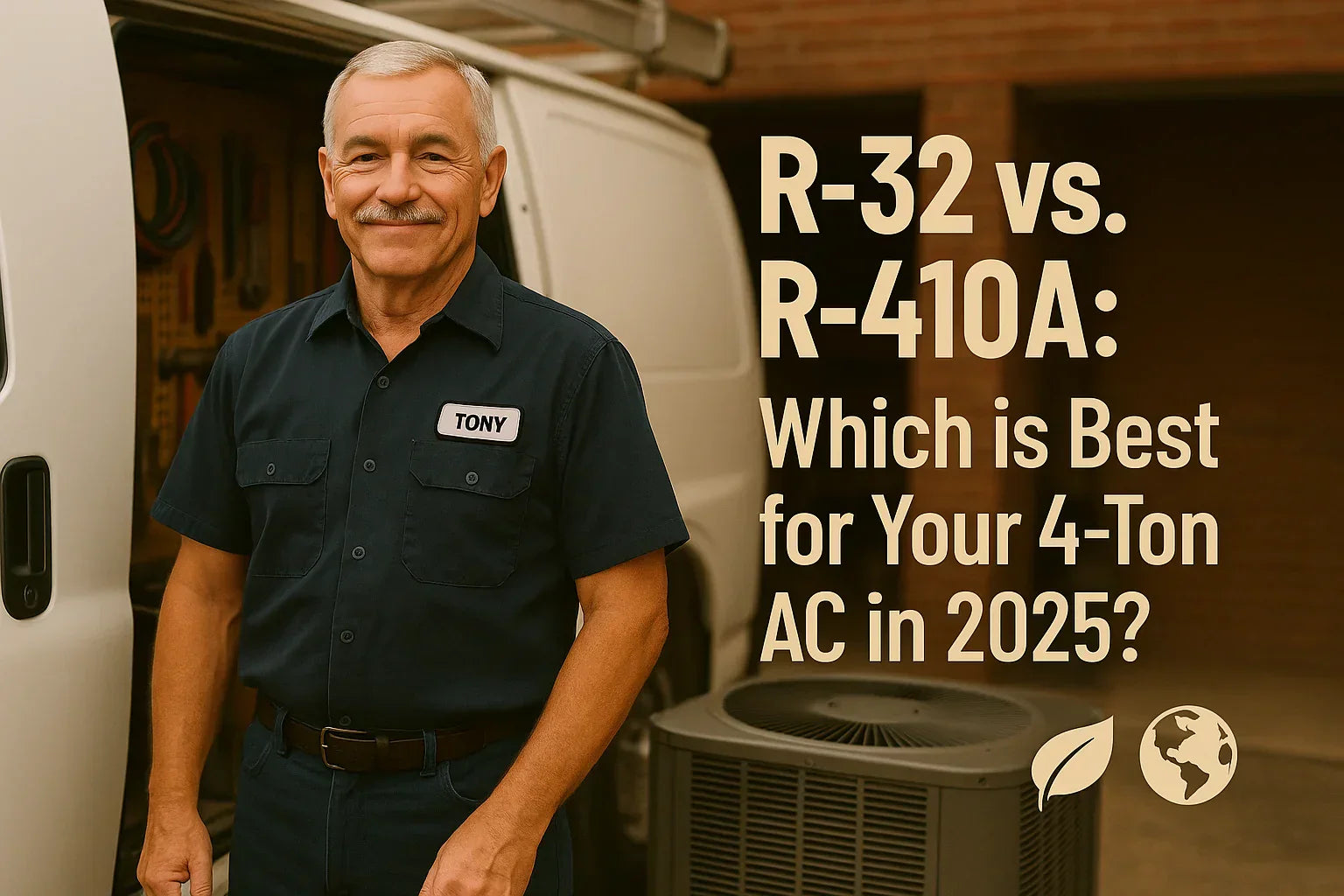If you’re planning to upgrade to a 4-ton AC system, you’ll encounter a major decision: Should you choose R-32 or R-410A refrigerant? As the HVAC industry shifts toward lower Global Warming Potential (GWP) refrigerants, understanding these options is crucial for making a future-ready investment.
This guide explains the key differences, environmental impacts, efficiency, safety considerations, availability, and what Tony recommends for smart homeowners planning a 4-ton upgrade in 2025.
💧 What Are R-32 and R-410A Refrigerants?
R-410A is a hydrofluorocarbon (HFC) refrigerant blend commonly used in residential HVAC systems since the phase-out of R-22. It offers high cooling efficiency but has a high GWP of 2,088.
R-32 is a next-generation HFC with a GWP of 675, making it nearly 70% lower in environmental impact than R-410A while delivering excellent efficiency in cooling.
Learn more about refrigerants on the U.S. EPA refrigerants page.
🌱 Environmental Impact: Why It Matters
Global Warming Potential (GWP)
-
R-410A: GWP 2,088
-
R-32: GWP 675
With the EPA's phasedown schedule for high-GWP refrigerants under the AIM Act, R-410A is being phased out, and R-32 aligns with these regulations while significantly reducing environmental impact.
Read more on the EPA AIM Act and refrigerant phase-downs.
🌬️ Efficiency and Performance Differences
R-32 offers:
-
Higher heat transfer efficiency: Allows systems to use less refrigerant for the same capacity.
-
Lower pressure drops: Reducing compressor workload.
-
Potentially higher SEER2 ratings: Many R-32 systems achieve SEER2 levels above 15, meeting 2025 efficiency standards.
This translates to lower energy bills while maintaining cooling power, especially in hot climates.
Check Energy Star guidelines for efficiency requirements here.
🔥 Safety Considerations
Flammability
R-32 is classified as mildly flammable (A2L), while R-410A is non-flammable (A1). However, with proper installation and handling, R-32 systems are safe and approved for residential use.
Tony's note: "Don’t let the flammability classification scare you off — modern systems are designed with protective measures, and certified technicians handle R-32 safely."
For details, see ASHRAE refrigerant classifications.
🌍 Availability and Future-Proofing
Availability
R-410A is still available in many regions but will gradually become more expensive as production reduces.
R-32 systems are increasingly available in 4-ton capacity models from Goodman, Daikin, and other major brands, ensuring supply and technician familiarity.
Future-Proofing
Choosing R-32 now ensures:
-
Easier refrigerant refills in the future
-
Compliance with phasedown regulations
-
Higher resale value for your HVAC system
Learn about Daikin’s R-32 initiatives here.
💰 Cost Differences
Equipment Costs:
-
R-32 and R-410A systems in 2025 are similar in initial unit pricing.
-
R-32 systems may be slightly lower due to reduced refrigerant volume needs.
Installation Costs:
-
Similar, but some contractors may charge slightly more for R-32 if additional safety steps are required.
Long-Term Savings:
-
R-32 systems tend to reduce electricity bills due to higher efficiency, saving $150–$300/year on average depending on usage.
🏡 Compatibility With 4-Ton AC Systems
R-32 is now available in many 4-ton AC systems, including split systems and packaged units.
Note: You cannot simply replace R-410A refrigerant in an existing system with R-32 due to compressor and oil incompatibility; switching to R-32 requires a system upgrade.
Learn about system compatibility on HVAC School.
⚖️ Rebates, Tax Credits, and Regulations
Rebates:
-
Energy-efficient R-32 systems may qualify for rebates under the Inflation Reduction Act.
-
State-specific rebates may also apply for high-efficiency systems.
Tax Credits:
-
Federal tax credits are available for systems meeting specific SEER2 ratings.
Check your eligibility and current rebate programs on the DSIRE database.
💡 What Does Tony Recommend?
"If you’re planning a 4-ton AC upgrade in 2025, R-32 is the smart, future-proof choice. It aligns with upcoming refrigerant regulations, offers higher efficiency, and reduces your environmental footprint without sacrificing comfort."
Key Takeaways:
-
Choose R-32 if buying a new system.
-
Confirm your system meets SEER2 requirements to qualify for rebates.
-
Hire a licensed professional familiar with R-32 for safe installation.
-
Ensure your ductwork and electrical capacity align with your new system needs.
💤 Final Thoughts: Is R-32 Right for Your 4-Ton AC Upgrade?
R-32 is rapidly becoming the standard for residential HVAC systems due to its:
-
Lower environmental impact
-
High energy efficiency
-
Availability in 4-ton systems
-
Compliance with future regulations
If your goal is long-term cost savings, environmental responsibility, and future readiness, R-32 is your clear choice for a 4-ton AC system.
🚀 Next Steps
-
Request a Manual J load calculation to confirm 4-ton sizing.
-
Compare R-32 4-ton system quotes from local installers.
-
Check rebate and tax credit eligibility in your state.
-
Plan your installation timing before peak summer demand.
-
Set up a maintenance plan for your new system to maximize efficiency.
Ready to future-proof your home comfort system? Contact your local HVAC professional or explore R-32 4-ton systems now on The Furnace Outlet.
In the next topic we will know more about: How to Maintain Your 4-Ton R-32 AC and Gas Furnace for Peak Performance







